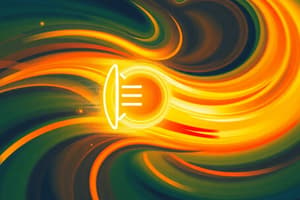Podcast
Questions and Answers
What is the formula for calculating kinetic energy?
What is the formula for calculating kinetic energy?
- E = ½mv² (correct)
- E = mgh
- E = ½ke²
- E = mcΔT
Which type of energy is associated with an object's position in a gravitational field?
Which type of energy is associated with an object's position in a gravitational field?
- Thermal energy
- Kinetic energy
- Gravitational potential energy (correct)
- Chemical potential energy
How is power defined in relation to energy transfer?
How is power defined in relation to energy transfer?
- Power is the total energy in a system.
- Power is the energy stored in a system.
- Power is the rate of energy transferred. (correct)
- Power is the amount of energy converted to matter.
What describes the opposition to the flow of current in a circuit?
What describes the opposition to the flow of current in a circuit?
Which equation represents the relationship between gravitational potential energy lost and kinetic energy gained?
Which equation represents the relationship between gravitational potential energy lost and kinetic energy gained?
What type of energy is stored in the chemical bonds of molecules?
What type of energy is stored in the chemical bonds of molecules?
What does specific heat capacity measure?
What does specific heat capacity measure?
What is the conventional direction of current flow in a circuit?
What is the conventional direction of current flow in a circuit?
What describes the current in a series circuit?
What describes the current in a series circuit?
Which equation represents Ohm's Law?
Which equation represents Ohm's Law?
What type of resistor changes resistance based on temperature?
What type of resistor changes resistance based on temperature?
What happens when more resistors are added in parallel?
What happens when more resistors are added in parallel?
Which component carries a fluctuating voltage of around 230V?
Which component carries a fluctuating voltage of around 230V?
What is the primary function of a step-down transformer?
What is the primary function of a step-down transformer?
What particle is emitted during alpha radiation?
What particle is emitted during alpha radiation?
Which type of current flows back and forth?
Which type of current flows back and forth?
What does half-life describe?
What does half-life describe?
What process involves the combining of two light nuclei?
What process involves the combining of two light nuclei?
What is the function of a fuse in an electrical circuit?
What is the function of a fuse in an electrical circuit?
Which radiation type has the highest penetrating power?
Which radiation type has the highest penetrating power?
Which equation calculates power in an electrical circuit?
Which equation calculates power in an electrical circuit?
Flashcards
Total Energy Conservation
Total Energy Conservation
In a closed system, energy cannot be created or destroyed.
Kinetic Energy (KE)
Kinetic Energy (KE)
Energy of motion, calculated with E = ½mv².
Gravitational Potential Energy (GPE)
Gravitational Potential Energy (GPE)
Energy due to an object's position, calculated with E = mgh.
Specific Heat Capacity (SHC)
Specific Heat Capacity (SHC)
Signup and view all the flashcards
Power
Power
Signup and view all the flashcards
Efficiency
Efficiency
Signup and view all the flashcards
Electric Current
Electric Current
Signup and view all the flashcards
Resistance
Resistance
Signup and view all the flashcards
Resistor
Resistor
Signup and view all the flashcards
Filament Bulb
Filament Bulb
Signup and view all the flashcards
Ohm's Law
Ohm's Law
Signup and view all the flashcards
Series Circuit
Series Circuit
Signup and view all the flashcards
Parallel Circuit
Parallel Circuit
Signup and view all the flashcards
Thermistor
Thermistor
Signup and view all the flashcards
LDR
LDR
Signup and view all the flashcards
Power Equation
Power Equation
Signup and view all the flashcards
Direct Current (DC)
Direct Current (DC)
Signup and view all the flashcards
Alternating Current (AC)
Alternating Current (AC)
Signup and view all the flashcards
Radioactive Decay
Radioactive Decay
Signup and view all the flashcards
Half-Life
Half-Life
Signup and view all the flashcards
Nuclear Fission
Nuclear Fission
Signup and view all the flashcards
Nuclear Fusion
Nuclear Fusion
Signup and view all the flashcards
Energy Transfer
Energy Transfer
Signup and view all the flashcards
Study Notes
Energy stores
- Energy quantifies the effects of object interactions in a system.
- Total energy is conserved in a closed system; it cannot be created or destroyed, but can be converted into matter.
- Energy exists in various forms: kinetic energy (KE), gravitational potential energy (GPE), elastic potential energy, thermal energy, and chemical potential energy.
- KE is the energy of motion, calculated as
E = ½mv², where 'm' is mass and 'v' is velocity. - GPE is energy due to an object's position, calculated as
E = mgh, where 'm' is mass, 'g' is acceleration due to gravity, and 'h' is height. - Elastic potential energy is stored in stretched or compressed objects:
E = ½ke², where 'k' is the spring constant and 'e' is the extension. - Thermal energy is energy from particle random motion:
E = mcΔT, where 'm' is mass, 'c' is specific heat capacity, and ΔT is the temperature change. - Chemical potential energy is stored in molecular bonds.
Energy transfers
- Energy transfer between objects or energy stores is necessary for system change.
- Energy loss to the surroundings signifies an open system.
- Work is another term for energy used.
- A roller coaster at the top of a hill has GPE, no KE. As it falls, GPE converts to KE.
- At the bottom, GPE lost equals KE gained.
- Calculating the roller coaster's speed at the bottom using KE:
v = √(2KE/m). - Alternatively, using GPE and KE directly:
v = √(2gh).
Specific heat capacity & Power
- Specific heat capacity (SHC) shows energy to raise 1 kg of a substance by 1°C.
- Power is the rate of energy transfer, calculated as
P = E/t, where 'E' is energy and 't' is time. - Power units are Watts (W), equivalent to Joules per second (J/s).
- Efficiency measures useful energy output compared to total input:
Efficiency = Useful energy out / Total energy in, andEfficiency = Useful power out / Total power in.
Electricity
- Electricity is electron flow.
- Charge movement is current.
- Conventional current flows positive-to-negative, opposite electron flow.
- Potential difference (PD), or voltage, shows energy transferred per Coulomb of charge.
- Current is charge flow rate, measured in Amperes (A).
- Resistance opposes current flow.
- A resistor has constant resistance, and is "ohmic" (PD and current are directly proportional).
- A filament bulb has changing resistance, "non-ohmic" (PD and current are not proportional).
- Ohm's Law:
V = IR. - Circuit components can be wired in series or parallel.
Series circuits
- In a series circuit, the total PD is split among components.
- Current is the same through all components.
- Total resistance is the sum of all individual resistances.
Parallel circuits
- In a parallel circuit, PD is the same across each branch.
- Current is split between branches.
- Adding more resistors in parallel lowers the total resistance.
Resistor types
- Thermistors change resistance with temperature.
- LDRs change resistance with light intensity.
Power in electrical circuits
- Electrical circuit power:
P = VI. - Alternative power equations from Ohm's Law:
P = I²RandP = V²/R.
Direct and alternating current
- Direct current (DC) flows in one direction.
- Alternating current (AC) flows back and forth, used in household power.
- UK AC frequency is 50 Hz.
Safety in electrical circuits
- Live wire (brown) carries fluctuating voltage, average 230V.
- Neutral wire (blue) has 0V potential.
- Earth wire (yellow/green) connects to plug's ground pin for safety during faults.
- Fuses (in live wire) melt if current exceeds limit.
- Appliance current:
I = P/V.
National grid
- A network of power stations, cables, and transformers delivering electricity.
- Transformers change voltage.
- Step-up transformers increase voltage, reduce current, decrease energy loss.
- Step-down transformers decrease voltage, making it suitable for homes.
Atomic structure
- Atoms contain a positive nucleus, with orbiting negative electrons.
- The nucleus has protons and neutrons.
- Atomic number is the number of protons.
- Mass number is the total protons and neutrons.
- Isotopes are atoms of the same element with different neutron counts.
Radiation
- Radiation is emitted particles or waves.
- The electromagnetic spectrum includes all types of radiation.
- Gamma radiation comes from the nucleus's excess energy.
- Alpha radiation is a particle of two protons and two neutrons (Helium nucleus).
- Beta radiation is a high-speed electron from neutron decay.
Radioactive decay
- Unstable nuclei decay to become stable.
- Alpha, beta, and gamma are decay types.
- Alpha has high ionization but low penetration.
- Beta has moderate ionization and penetration.
- Gamma has low ionization but high penetration.
Half-life
- Half-life is decay time for half the activity of a radioactive source.
- Half-life is also the time for half the unstable nuclei to decay, and half the sample's mass.
Nuclear fission
- Fission splits a heavy nucleus (e.g., uranium-235) into lighter nuclei.
- Fission releases heat and kinetic energy.
Nuclear fusion
- Fusion combines light nuclei (e.g., hydrogen) into a heavier nucleus.
- Fusion releases more energy than fission.
- Fusion needs high temps and pressures.
Key concepts
- Energy is conserved.
- Power is energy transfer rate, and efficiency measures useful energy.
- Electricity is charge flow, and PD is energy per Coulomb.
- Resistance opposes flow, and Ohm's Law relates PD, current, and resistance.
- Circuits have series and parallel connections.
- Atoms have protons, neutrons, and electrons.
- Radioactive decay changes unstable nuclei.
- Nuclear fission splits heavy nuclei, and nuclear fusion joins light ones.
Studying That Suits You
Use AI to generate personalized quizzes and flashcards to suit your learning preferences.




